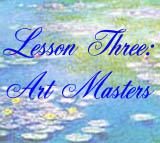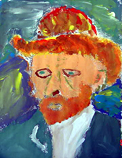 |
 |
 |
 |
 |
 |
|
|
|
|
|
|
|
|
|
|
|
|
Instructional Objectives: Students will access the Internet, research an artist, view various works of art of the master, determine the characteristics of the style of art, and create an original work of art in the style of the master.
Fine Art -Visual Art
1.0 ARTISTIC PERCEPTION Processing, analyzing, and responding to sensory information through the language and skills unique to the visual arts. Students perceive and respond to works of art, objects in nature, events, and the environment. They also use the vocabulary of the visual arts to express their observations.
2.0 CREATIVE EXPRESSION Creating, performing, and participating in the visual arts. Students apply artistic processes and skills, using a variety of media to communicate meaning and intent in original works of art.
Time Required: Three, forty-five minute periods
Advance preparation and prerequisite knowledge and skills: Students should be able to search a website, download a graphic from the Internet and print the graphic. Students should understand that there are different styles of art and different mediums used to create art pieces.
Materials and resources required: Computer with Internet access, art supplies such as paper, chalk, water colors and tempera paints.
Abstract expressionism: A movement in painting, originating in New York City in the 1940s. It emphasized spontaneous personal expression, freedom from accepted artistic values, surface qualities of paint, and the act of painting itself. Pollock, de Kooning, Motherwell, and Kline, are important abstract expressionists.
Baroque: A movement in European painting in the seventeenth and early eighteenth centuries, characterized by violent movement, strong emotion, and dramatic lighting and coloring. Bernini, Caravaggio and Rubens were among important baroque artists.
Cubism: A revolutionary movement begun by Picasso and Braque in the early twentieth century. It employs an analytic vision based on fragmentation and multiple viewpoints.
Impressionism: Late 19th-century French school dedicated to defining transitory visual impressions painted directly from nature, with light and color of primary importance. If the atmosphere changed, a totally different picture would emerge. It was not the object or event that counted but the visual impression as caught at a certain time of day under a certain light. Claude Monet and Camille Pissarro were leaders of the movement.
Surrealism: A movement of the 1920s and 1930s that began in France. It explored the unconscious, often using images from dreams. It used spontaneous techniques and featured unexpected juxtapositions of objects. Magritte, Dali, Miro, and Ernst painted surrealist works.
Realism: In a general sense, refers to objective representation. More specifically, a nineteenth century movement, especially in France, that rejected idealized academic styles in favor of everyday subjects. Daumier, Millet, and Courbet were realists.
Postimpressionism: A term coined by British art critic Roger Fry to refer to a group of nineteenth-century painters, including Cezanne, Van Gogh, and Gauguin, who were dissatisfied with the limitations of expressionism. It has since been used to refer to various reactions against impressionism, such as fauvism and expressionism.
Procedures: Students will select or be assigned an artist. Review how to use a search engine to find Internet sites or how to access a given site. Review how to scan information, take notes, download graphics, and the procedure for saving and printing the graphics. Discuss the different descriptive movements (or styles) that artists are often grouped into (and the artists associated with each) such as Abstract (Pollock), Baroque (Rembrandt), Cubism (Picasso), Impressionism (Monet), Post Impressionism (Van Gogh), Surrealism (Dali), or Realism (O'Keefe). Students will gather information about their chosen artist while viewing Internet sites. They will then print a work of art by their chosen artist. Students will then create an original piece of art in the style of the artist using the appropriate medium such as water colors, chalk, pencil, or tempera paint (use tempera instead of oil paints).
Students will:
Evaluation: The evaluation is based on the students' attempts to capture the essence of the artist's style in the art pieces and explain the major features of the artist's style.
|
|
|
| Student was able to locate, download and print a sample of the artist's work. | Student did not print a sample of the artist's work. |
| Student created an original work of art. | Student did not complete an original work of art. |
| The student was able to explain at least two ways in which the art piece represented the artist's style. | The student was unable to explain at least two ways in which the art piece represented the artist's style. |
Homework: Students will do a museum search to locate works of their artist in the United States.
Extension: Students will research a second artist from a different era or school of art and compare and contrast the style of each.
Student Work Samples: Click here for student samples